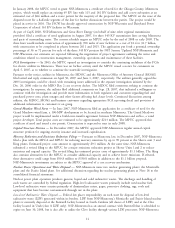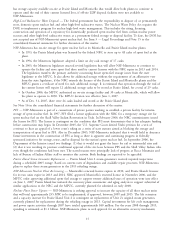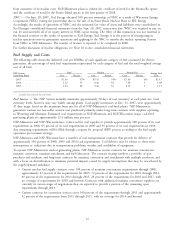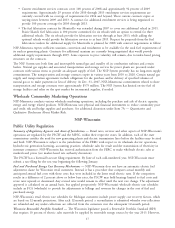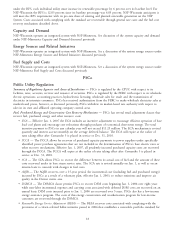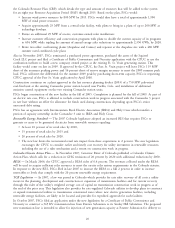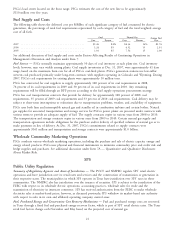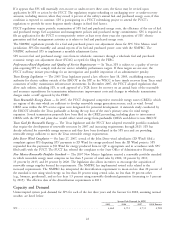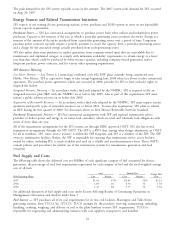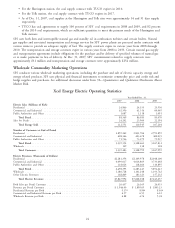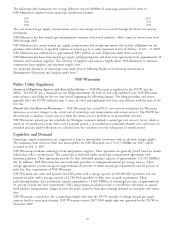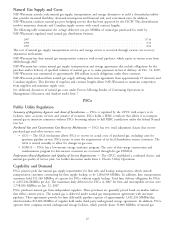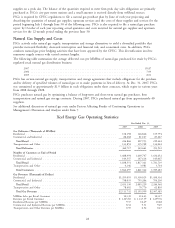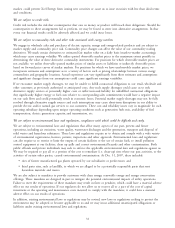Xcel Energy 2007 Annual Report Download - page 33
Download and view the complete annual report
Please find page 33 of the 2007 Xcel Energy annual report below. You can navigate through the pages in the report by either clicking on the pages listed below, or by using the keyword search tool below to find specific information within the annual report.
The peak demand for the SPS system typically occurs in the summer. The 2007 system peak demand for SPS occurred
on Aug. 20, 2007.
Energy Sources and Related Transmission Initiatives
SPS expects to use existing electric generating stations, power purchases and DSM options to meet its net dependable
system capacity requirements.
Purchased Power — SPS has contractual arrangements to purchase power from other utilities and independent power
producers. Capacity is the measure of the rate at which a particular generating source produces electricity. Energy is a
measure of the amount of electricity produced from a particular generating source over a period of time. Long-term
purchase power contracts typically require a periodic payment to secure the capacity from a particular generating source
and a charge for the associated energy actually purchased from such generating source.
SPS also makes short-term purchases to replace generation from company-owned units that are unavailable due to
maintenance and unplanned outages, to comply with minimum availability requirements, to obtain energy at a lower
cost than that which could be produced by other resource options, including company-owned generation and/or
long-term purchase power contracts, and for various other operating requirements.
SPS Resource Planning
Lea Power Partners — Lea Power is a natural gas combined cycle 602 MW plant currently being constructed near
Hobbs, New Mexico. SPS is expected to begin to take energy beginning June 2008 when Lea Power reaches commercial
operations. The purchase power agreement, which was executed in 2006, provides for SPS to have exclusive rights to
dispatch the facility.
Integrated Resource Planning — In accordance with a final rule adopted by the NMPRC, SPS is required to file an
integrated resource plan (IRP) with the NMPRC on or before July 2009. Also as part of this requirement, SPS must
initiate a public advisory process on or before July 2008.
Acquisition of Renewable Resources — In accordance with a final rule adopted by the NMPRC, SPS must require certain
quantities and specific types of renewable resources on or before 2011. To meet this requirement, SPS plans to submit
an RFP during the first quarter of 2008. See discussion above on New Mexico Renewable Portfolio Standard.
Purchased Transmission Services — SPS has contractual arrangements with SPP and regional transmission service
providers to deliver power and energy to its native load customers, which are retail and wholesale load obligations with
terms of more than one year.
All of the transmission arrangements for the SPS systems are through FERC approved OATT. SPS also has several
transmission arrangements through the SPP OATT. The SPP is a RTO that, among other things, administers an OATT
for all its members. SPS’ entire service territory is within the SPP footprint, and SPS is a member of the SPP. The SPP
owns no transmission facilities. Rather, the SPP is responsible for ensuring that transmission service across facilities
owned by others, including SPS, is made available and used on a reliable and non-discriminatory basis. These OATTs
contain policies and procedures for reliable use of the transmission systems for transmission, generation and load
variations.
Fuel Supply and Costs
The following table shows the delivered cost per MMBtu of each significant category of fuel consumed for electric
generation, the percentage of total fuel requirements represented by each category of fuel and the total weighted average
cost of all fuels.
Coal Natural Gas Average Fuel
SPS Generating Plants Cost Percent Cost Percent Cost
2007 ...................................... $1.64 67% $6.45 33% $3.22
2006 ...................................... 1.89 66 6.30 34 3.38
2005 ...................................... 1.32 68 7.77 32 3.38
See additional discussion of fuel supply and costs under Factors Affecting Results of Continuing Operations in
Management’s Discussion and Analysis under Item 7.
Fuel Sources — SPS purchases all of its coal requirements for its two coal facilities, Harrington and Tolk electric
generating stations, from TUCO, Inc (TUCO). TUCO arranges for the purchase, receiving, transporting, unloading,
handling, crushing, weighing, and delivery of coal to the plant bunkers to meet SPS’ requirements. TUCO is
responsible for negotiating and administering contracts with coal suppliers, transporters, and handlers.
23



